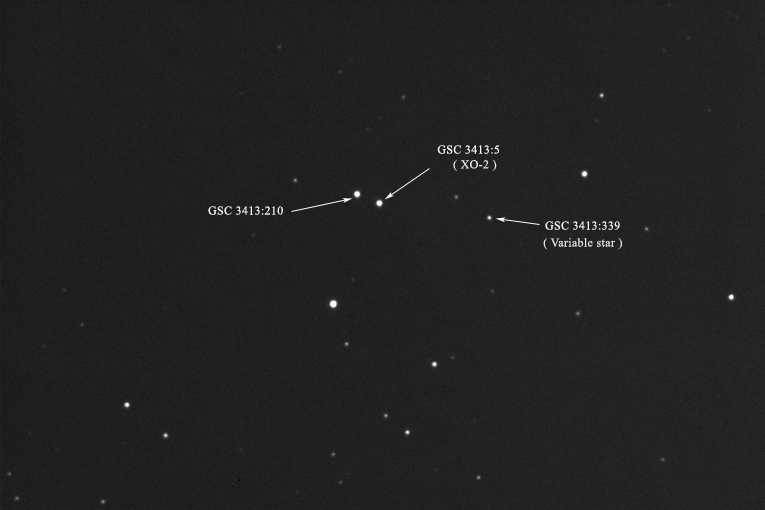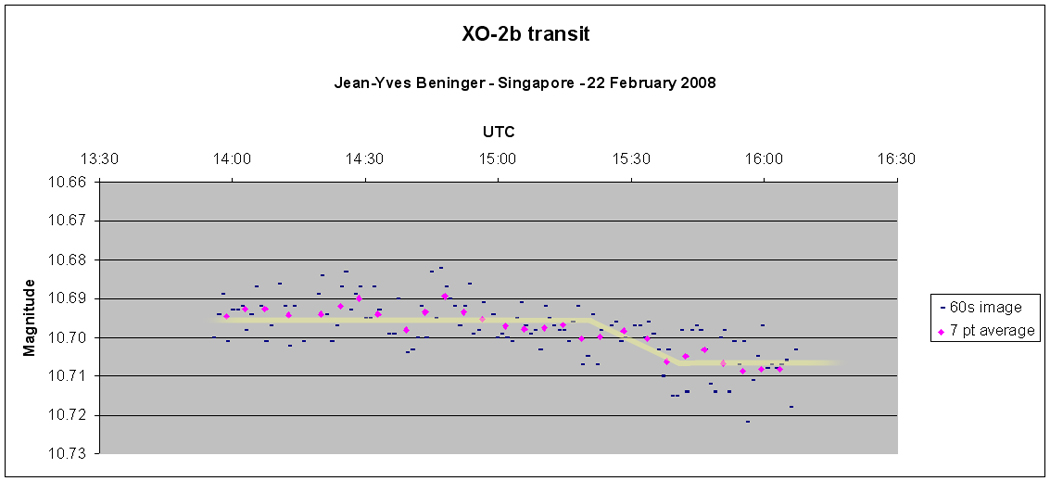|
XO-2b Extrasolar Planet Transit XO-2b is an extrasolar planet orbiting Star GSC 3413:5 whith an orbit in our line of sight, thus transiting its star as seen from Earth. Refer to May 2007 public announcement here
Image taken from Singapore at 15:00 GMT on 17 February 2008 XO-2b is a great target for an amateur astronomer and ideally located in January and February skies: - Galactic coordinates (epoch 2000) RA= 07h 48mn 06s Dec= +50° 13' 34"; - its host star has a companion, GSC 3413:210, of similar color and magnitude 31' apart, an ideal comparison star; - Transit depth is 1.15%; - Period is 2.6 days; - A variable star, GSC 3413:339, in the same field of view, has a short one hour period, a good acquisition test; |
|
Equipment: LX200R 10 inch AP Mach1 mount SBIG ST8XME NABG camera Windows XP CCDSoft acquisition software TheSky6 software Weather preparation nights: 17 February 2008: warm, humid, clear skies, light wind, moon 86% 19 February 2008: warm, humid, hazy to cloudy skies, moon 98% 20 February 2008: warm, humid, hazy skies, light wind, full moon Weather transit night: 22 February 2008: warm, humid, clear to hazy skies, no wind, moon 96% |
|
|
Choice of bin size for acquisition with a clear filter On 17 February, I captured 2 sets of images: 60 guided images / 2 minutes per image / bin 1x1 (0.65 degres per pixel) and 60 guided images / 1 minute per image / bin 2x2 (1.30 degres per pixel) The graphs below plot GSC 3413:5 magnitude as a function of time, using GSC 3413:210 as a comparison star. Bin 2x2 is a better fit for the acquisition setup. |
|
Bin 1x1
|
Bin 2x2
|
|
Choice of acquisition filter I captured another set of images on 19 February, using a red filter to reduce the luminosity gradients caused by the full moon shining in the East. That session was cut short with clouds closing in after half an hour of acquisition. The results with the Red filter look promising and that will be the choice for transit night. The graphs below plot GSC 3413:5 magnitude as a function of time, using GSC 3413:210 as a comparison star, on 17 February and 19 February. |
|
Clear filter
|
Red filter
|
|
Transit ingress Transit was expected at 15:22 UTC on 22 February Despite a rainy day and cloudy evening, the sky started clearing up a few hours before transit. The graph below plots GSC 3413:5 magnitude as a function of time, using GSC 3413:210 as a comparison star, during the acquisition period until the target star went below 30 degrees altitude. We can clearly see ingress of the transit and a drop of 0.01 magnitude in the star brightness. |
|
|
|
GSC 3413:339 variable star The graph below plots GSC 3413:339 magnitude as a function of time, using GSC 3413:210 as a comparison star, during the acquisition period until the target star went below 30 degrees altitude. Note the sinusoidal fitting (software starbright developped by Jean-Jacques Chameau) with a period of just less than one hour. Raw data is in blue and medium smoothed data in red. |
|
|






